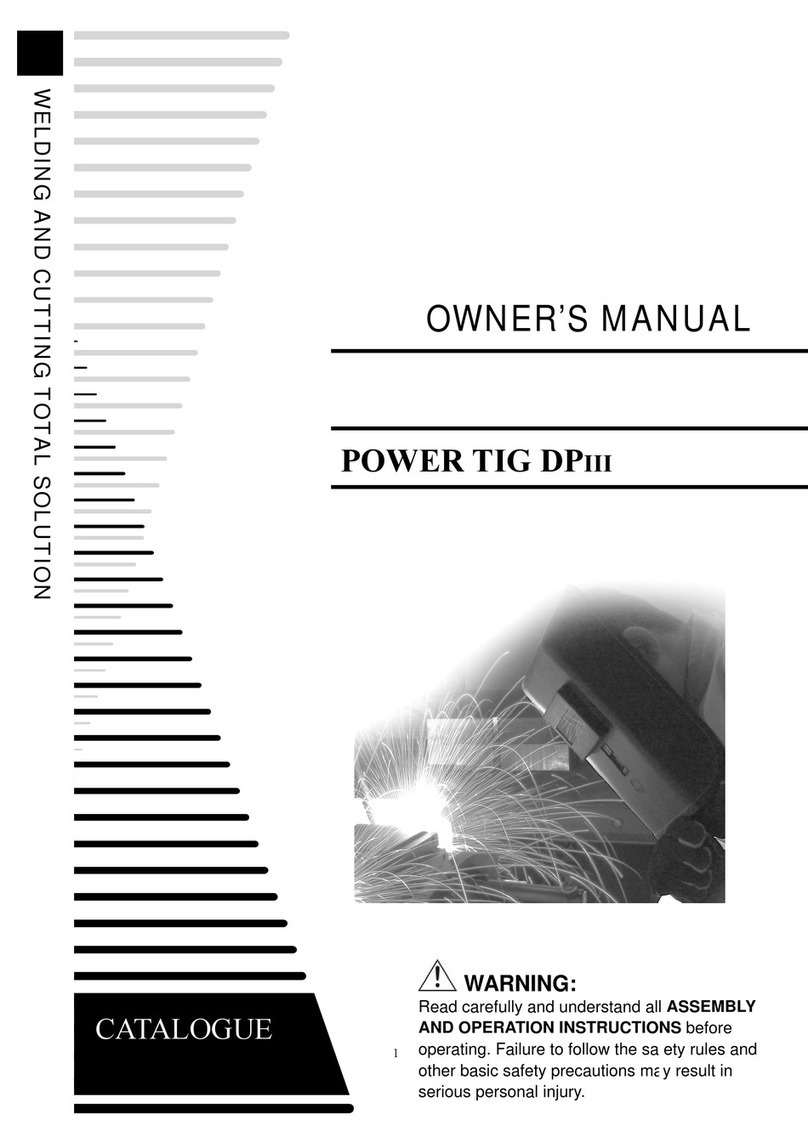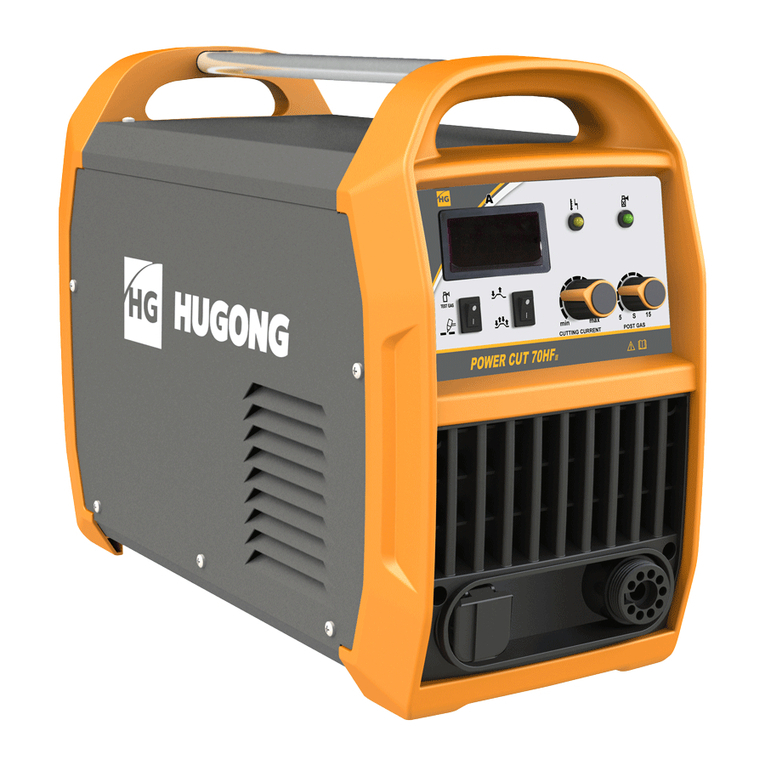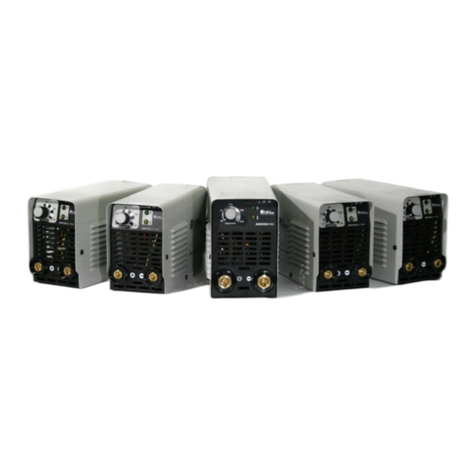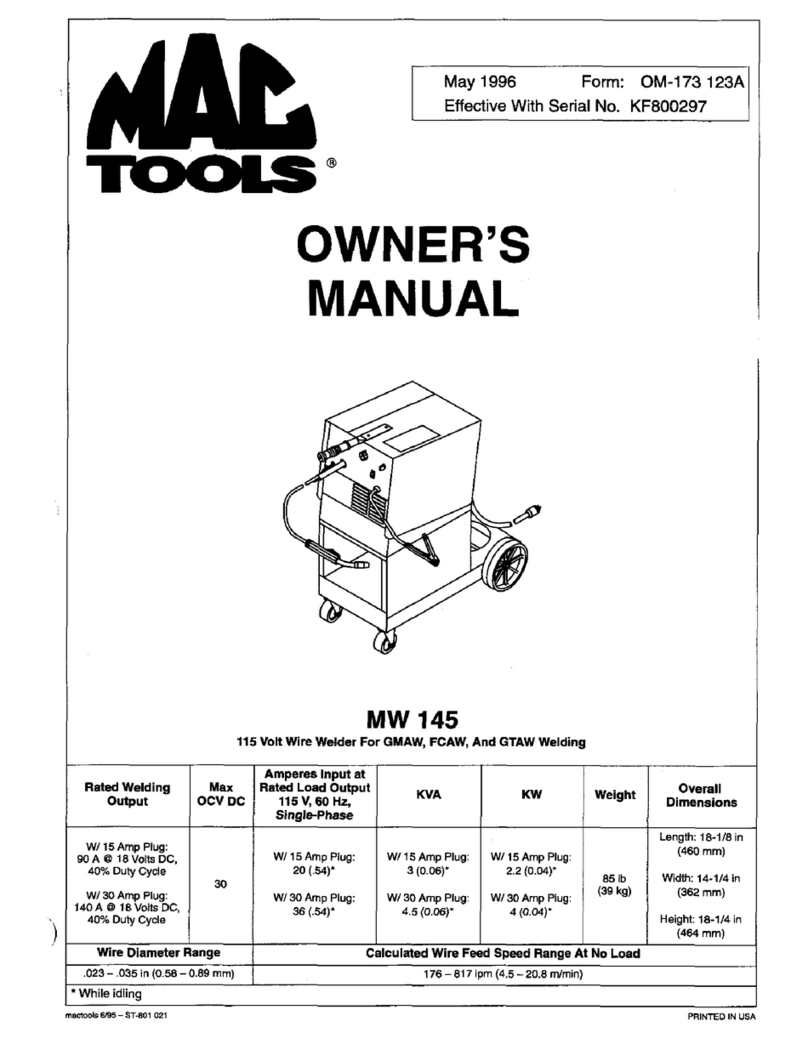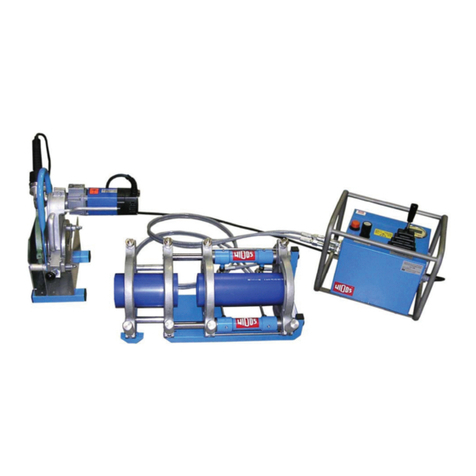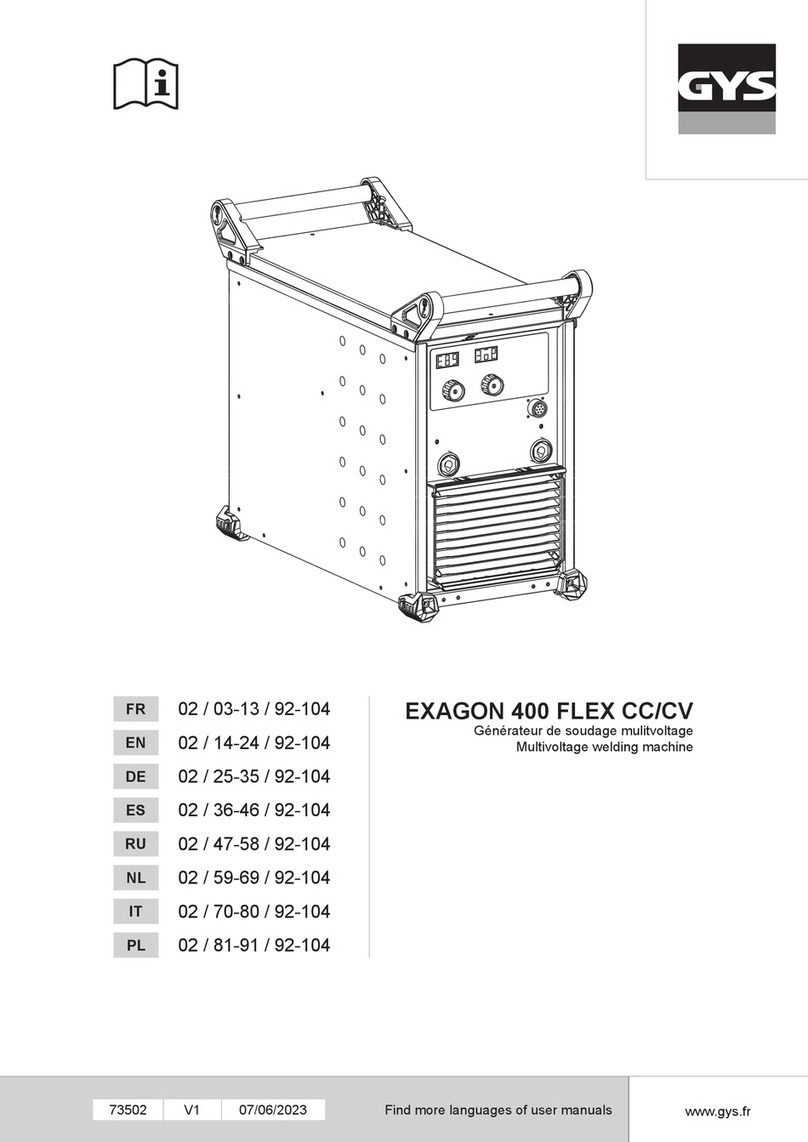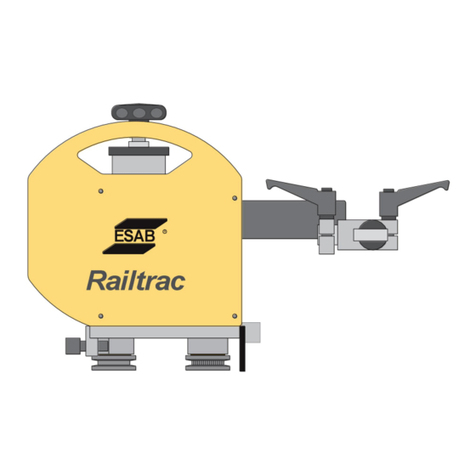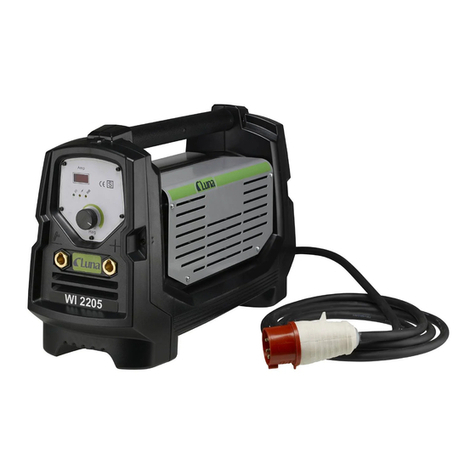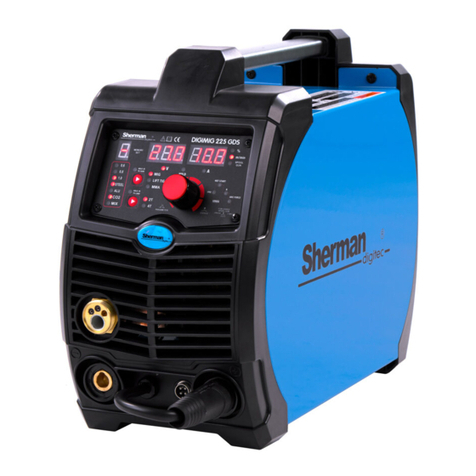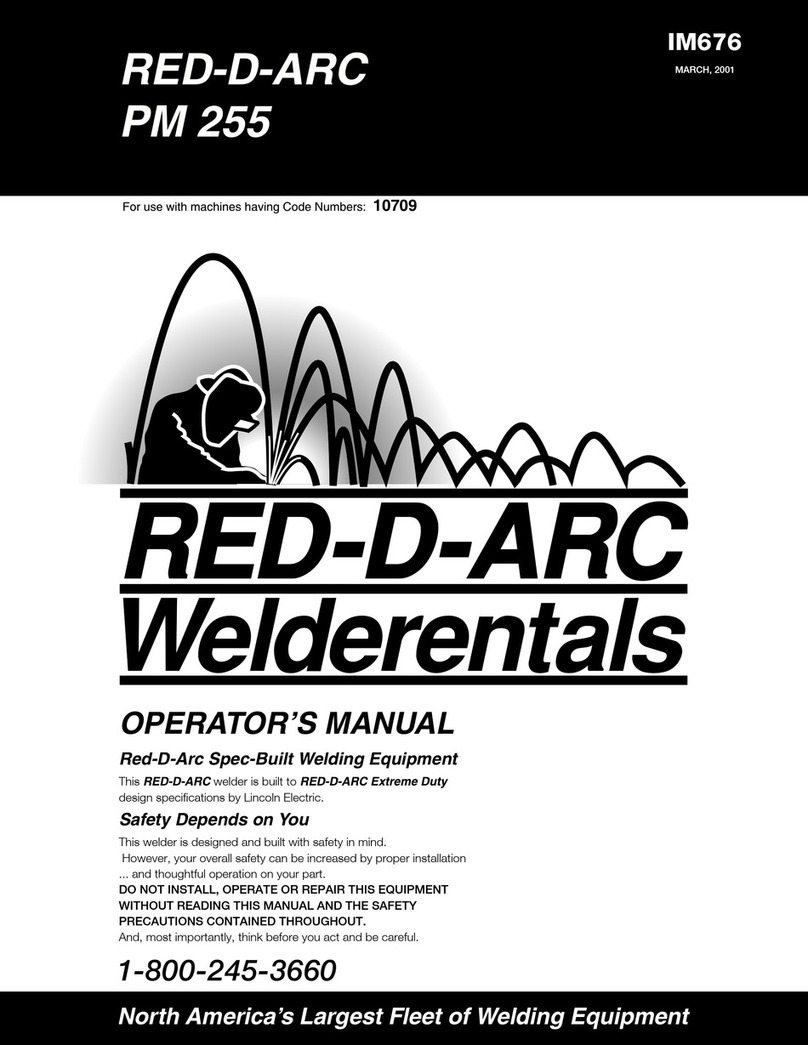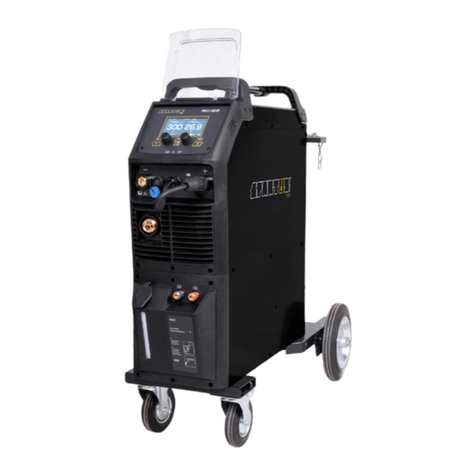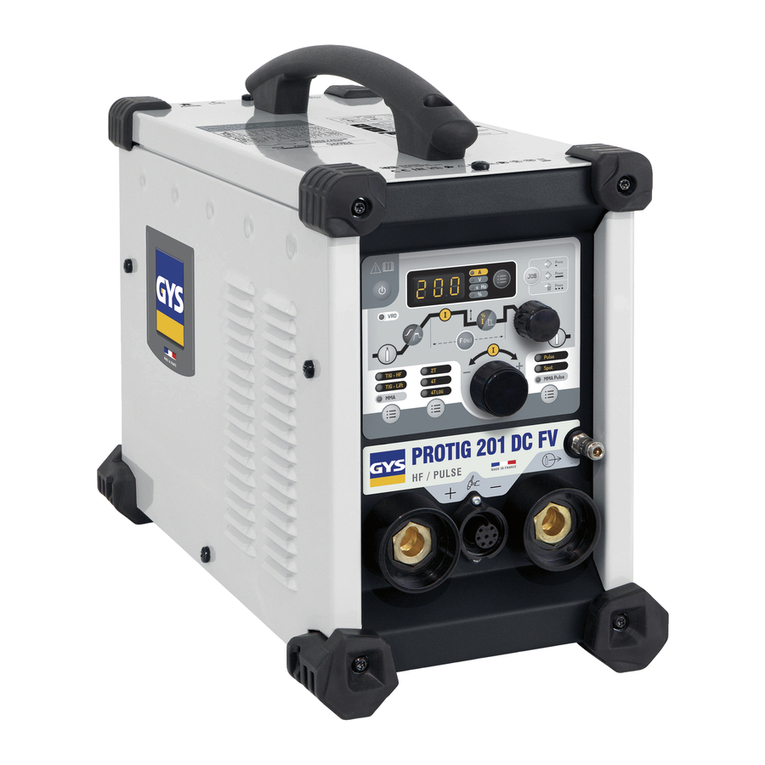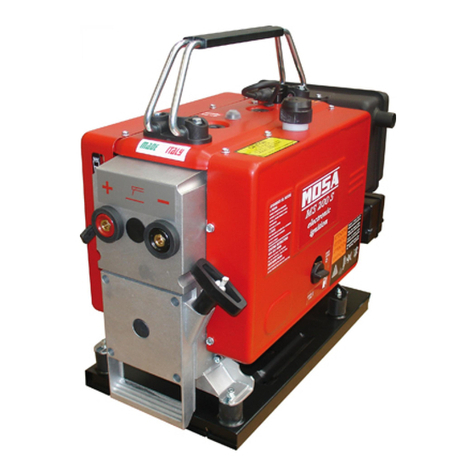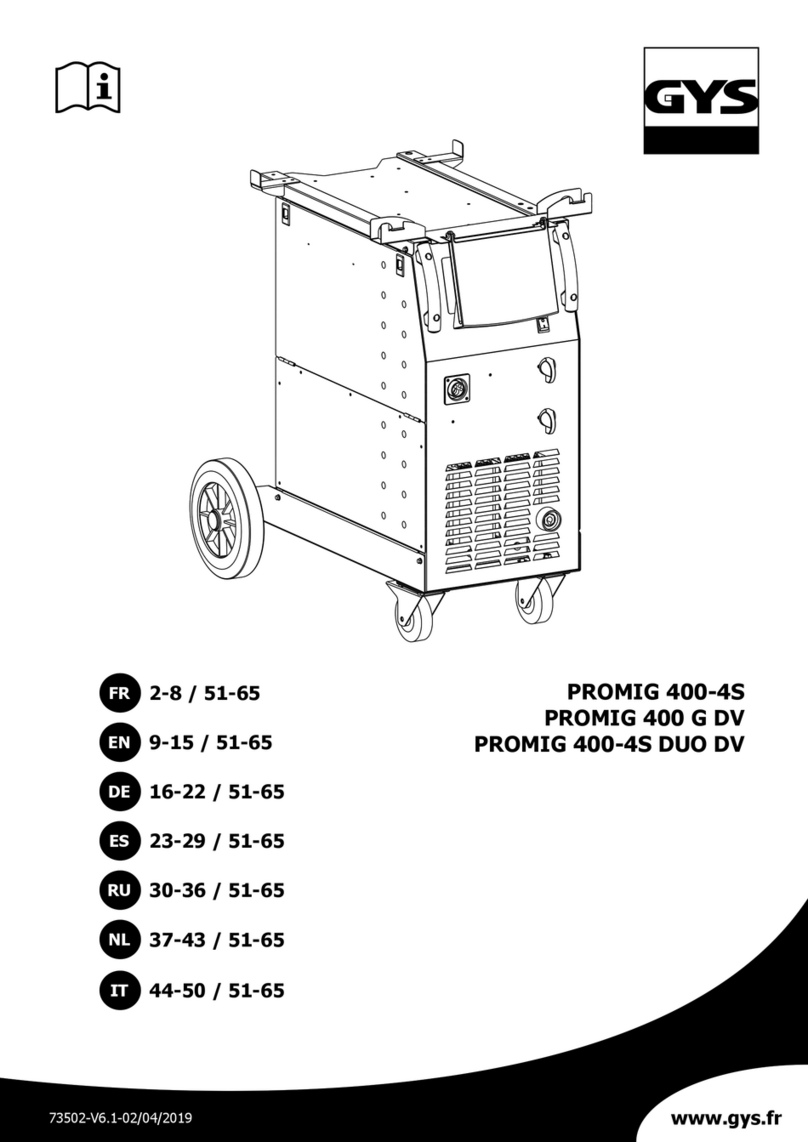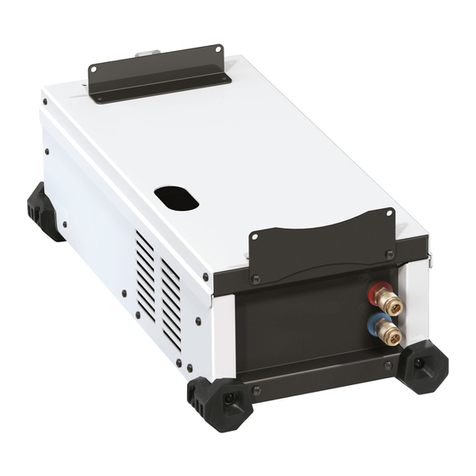Mweld WAVE 200DIII User manual

1
WAVE 200DIII
WARNING:
Read carefully and understand all ASSEMBLY
AND OPERATION INSTRUCTIONS before
operating. Failure to follow the safety rules and
other basic safety precautions may result in
serious personal injury.
2015VERSION
OWNER’S MANUAL
WELDING AND CUTTING TOTAL SOLUTION

2
CATALOGUE
GENERALSAFETYRULES
TECHNICALSPECIFICATION
KNOW YOUR WELDER
INSTALLATION
OPERATION
TROUBLESHOOTING
DIAGRAM & PARTS LIST

3
GENERAL SAFETY RULES
WARNING: Read and understand all instructions. Failure to follow all instructions listed below may result in
serious injury.
CAUTION: Do not allow persons to operate or assemble this WAVE 200DIII until they have read this manual
and have developed a thorough understanding of how the WAVE 200DIII works.
WARNING: The warnings, cautions, and instructions discussed in this instruction manual cannot cover all
possible conditions or situations that could occur. It must be understood by the operator that common sense
and caution are factors which cannot be built into this product, but must be supplied by the operator.
1.1 Your Welding Environment
-Keep the environment you will be welding in free from flammable materials.
-Always keep a fire extinguisher accessible to your welding environment.
-Always have a qualified person install and operate this equipment.
-Make sure the area is clean, dry and ventilated. Do not operate the welder in humid, wet or poorly ventilated
areas.
-Always have your welder maintained by a qualified technician in accordance with local, state and national
codes.
-Always be aware of your work environment. Be sure to keep other people, especially children, away from
you while welding.
-Keep harmful arc rays shielded from the view of others.
-Mount the welder on a secure bench
or cart that will keep the welder secure and prevent it from tipping over or falling.
1.2 Your Welder’s Condition
-Check ground cable, power cord and welding cable to be sure the insulation is not damaged. Always replace
or repair damaged components before using the welder.
-Check all components to ensure they are clean and in good operating condition before use.
1.3 Use of Your Welder
Do not operate the welder if the output cable, electrode, torch, wire or wire feed system is wet. Do not
immerse them in water. These components and the welder must be completely dry before attempting to use
them.
-Follow the instructions in this manual.
-Keep welder in the off position when not in use.
-Connect ground lead as close to the area being welded as possible to ensure a good ground.
-Do not allow any body part to come in contact with the welding wire if you are in contact with the material
being welded, ground or electrode from another welder.
-Do not weld if you are in an awkward position. Always have a secure stance while welding to prevent
accidents. Wear a safety harness if working above ground.
-Do not drape cables over or around your body.
-Wear a full coverage helmet with appropriate shade (see ANSI Z87.1 safety standard) and safety glasses
while welding.
-Wear proper gloves and protective clothing to prevent your skin from being exposed to hot metals, UV and

4
IR rays.
-Do not overuse or overheat your welder. Allow proper cooling time between duty cycles.
-Keep hands and fingers away from moving parts and stay away from the drive rolls.
-Do not point torch at any body part of yourself or anyone else.
-Always use this welder in the rated duty cycle to prevent excessive heat and failure.
1.4 Specific Areas of Danger, Caution or Warning
Electrical Shock
Electric arc welders can produce a shock that can cause injury or death. Touching electrically live parts can
cause fatal shocks and severe burns. While welding, all metal components connected to the wire are
electrically hot. Poor ground connections are a hazard, so secure the ground lead before welding.
-Wear dry protective apparel: coat, shirt, gloves and insulated footwear.
-Insulate yourself from the work piece. Avoid contacting the work piece or ground.
- Do not attempt to repair or maintain the welder while the power is on.
-Inspect all cables and cords for any exposed wire and replace immediately if found.
-Use only recommended replacement cables and cords.
-Always attach ground clamp to the work piece or work table as close to the weld area as possible.
-Do not touch the welding wire and the ground or grounded work piece at the same time.
-Do not use a welder to thaw frozen pipes.
Fumes and Gases
-Fumes emitted from the welding process displace clean air and can result in injury or death.
-Do not breathe in fumes emitted by the welding process. Make sure your breathing air is clean and safe.
-Work only in a well-ventilated area or use a ventilation device to remove welding fumes from the
environment where you will be working.
-Do not weld on coated materials (galvanized, cadmium plated or containing zinc, mercury or barium).
They will emit harmful fumes that are dangerous to breathe. If necessary use a ventilator, respirator with air
supply or remove the coating from the material in the weld area.
-The fumes emitted from some metals when heated are extremely toxic. Refer to the material safety data sheet
for the manufacturer’s instructions.
-Do not weld near materials that will emit toxic fumes when heated. Vapors from cleaners, sprays and
degreasers can be highly toxic when heated.
UV and IR Arc Rays
EMBED Word.Picture.8
The welding arc produces ultraviolet (UV) and infrared (IR) rays that can cause injury to your eyes and skin.
Do not look at the welding arc without proper eye protection.
-Always use a helmet that covers your full face from the neck to top of head and to the back of each ear.
-Use a lens that meets ANSI standards and safety glasses. For welders under 160 Amps output, use a shade 10
lens; for above 160Amps, use a shade 12. Refer to the ANSI standard Z87.1 for more information.
-Cover all bare skin areas exposed to the arc with protective clothing and shoes. Flame-retardant cloth or
leather shirts, coats, pants or coveralls are available for protection.
-Use screens or other barriers to protect other people from the arc rays emitted from your welding.
-Warn people in your welding area when you are going to strike an arc so they can protect themselves.
Fire Hazards

5
Do not weld on containers or pipes that contain or have had flammable, gaseous or liquid
combustibles in them. Welding creates sparks and heat that can ignite flammable and
explosive materials.
-Do not operate any electric arc welder in areas where flammable or explosive materials are present.
-Remove all flammable materials within 35 feet of the welding arc. If removal is not possible, tightly cover
them with fireproof covers.
-Take precautions to ensure that flying sparks do not cause fires or explosions in hidden areas, cracks or areas
you cannot see.
-Keep a fire extinguisher close in the case of fire.
-Wear garments that are oil-free with no pockets or cuffs that will collect sparks.
-Do not have on your person any items that are combustible, such as lighters or matches.
-Keep work lead connected as close to the weld area as possible to prevent any unknown, unintended paths of
electrical current from causing electrical shock and fire hazards.
-To prevent any unintended arcs, cut wire back to ¼" stick out after welding.
Hot Materials
Welded materials are hot and can cause severe burns if handled improperly.
-Do not touch welded materials with bare hands.
-Do not touch TIG gun nozzle after welding until it has had time to cool down.
Sparks/Flying Debris
Welding creates hot sparks that can cause injury. Chipping slag off welds creates flying debris.
-Wear protective apparel at all times: ANSI-approved safety glasses or shield, welder’s hat and ear plugs to
keep sparks out of ears and hair.
Electromagnetic Field
-Electromagnetic fields can interfere with various electrical and electronic devices such as pacemakers.
-Consult your doctor before using any electric arc welder or cutting device
-Keep people with pacemakers away from your welding area when welding.
-Do not wrap cable around your body while welding.
-Wrap TIG gun and ground cable together whenever possible.
-Keep TIG gun and ground cables on the same side of your body.
Shielding Gas Cylinders Can Explode
High pressure cylinders can explode if damaged, so treat them carefully.
-Never expose cylinders to high heat, sparks, open flames, mechanical shocks or arcs.
-Do not touch cylinder with TIG gun.
-Do not weld on the cylinder
-Always secure cylinder upright to a cart or stationary object.
-Keep cylinders away from welding or electrical circuits.
-Use the proper regulators, gas hose and fittings for the specific application.

6
-Do not look into the valve when opening it.
-Use protective cylinder cap whenever possible
1.5 Proper Care, Maintenance and Repair
EMBED Word.Picture.8
-Always have power disconnected when working on internal components.
- Do not touch or handle PC board without being properly grounded with a wrist strap. Put PC board in static
proof bag to move or ship.
-Do not put hands or fingers near moving parts such as drive rolls of fan
WAVE 200DIII USE AND CARE
Do not modify the WAVE 200DIII in any way. Unauthorized modification may impair the function and/or
safety and could affect the life of the equipment. There are specific applications for which the WAVE 200DIII
was designed.
Always check of damaged or worn out parts before using the WAVE 200DIII. Broken parts will affect the
WAVE 200DIII operation. Replace or repair damaged or worn parts immediately.
Store idle WAVE 200DIII. When WAVE 200DIII is not in use, store it in a secure place out of the reach of
children. Inspect it for good working condition prior to storage and before re-use.
Notice: * If the welder continues to work too long time, the 【Protection Indicator】on the panel
would be on, indicating that the inner temperature rise inside the welder had exceed the
designed permitted temperature. At this time, stop the welding work, wait until the welder cooled inside
and the 【Protection Indicator】turned off, then continue to work again;
* Cut off the power switch and Argon valve, before leaving the welding place temporarily or after the
welding worked finished;
* Welders should wear canvas work clothes and welding face shield to prevent arc light and heat
radiation;
* Put light-proof screen around the work area to prevent others influenced by the arc lights.
* Flammable, explosive items could not be put near the welding area;
* Every outlet of the welder should be connected and earthed correctly.
Notice: The cover protection degree of the WAVE series Square Wave AC/DC pulsed inverter
TIG welder is IP21S.When the welder is operated, do not insert finger or round stick diameter less than
12.5mm (especially metal stick) into the welder; Do not allow to press heavily onto the welder.

7
TECHNICAL SPECIFICATION
TERM UNIT WAVE 200DIII WAVE 200DIII
Rated Input Voltage V 220 230
Power Frequency Hz 50/60 50/60
Rated Input Capacity KVA 7.9 7.9
RatedInputCurrent A 36 35
Output No Load Voltage V 65 68
Rated Working Voltage V 18 18
DC Argon Welding Current A 5~200 5~200
AC Argon Welding Current A 10~200 10~200
Stick Welding Current A 5~170 5~170
Current Up Time S 0~15 0~15
Current Drop Time S 0~25 0~25
Pulse Frequency Hz 0.5~200 0.5~200
Pulse Width Adjustment
(DC)
%
15~85 15~85
Clear Area Control(AC)% 15~65 15~65
Gas Stop Delay Time S 0~30 0~30
RatedDutyCycle % 35 35
Cooling Type Air cooling Air cooling
Effiency η≥85% ≥85%
Power Factor Cosφ0.92 0.92
InsulationDegree H H
Cover Protection Degree IP IP21S IP21S
Weight kg 19.8 19.8
Dimension L×W×H mm 500*240*410 500*240*410
No special advice on above parameter. The nameplate parameter on the welder is prior.

8
Welding regulations parameter table (only for reference)
Mode Material
Type
Designe
d Joint
WORK
Thicknes
s
(mm)
Wire
Dia
Φ
(mm)
Welding
Current
(A)
Polarity
Argon
Flow
(dm3/mi
n)
Tungste
n Stick
Dia Φ
(mm)
Angle
Top Dia
Φ
(mm)
DC Stainless
Steel
Vertical
Joint 1.6~3.0
1.6~2.5
50~90
DC
Positive
8~12
1.0 12~20° 0.12~0.25
V groove >3.0~6.0 70~120 1.6 25~30° 0.50~0.75
X groove >6.0~12 2.5~3.2 100~150 10~14 2.4 35~45° 0.75~1.10
AC
Pure
Aluminium,
Alu-Mag
Alloy
Vertical
Joint 1~2.5 1.6~2.5 45~90
Positive
2~6 2~3
90° 1.50
V groove 3~6 2~4 90~180 10~12 3~4
X groove 8~12 4~5 150~220 12~16 4~5
KNOW YOUR WELDER
Description
WAVE200KDii is a digitization model can be used for MMA、ACTIG 、DCTIG and PULSE TIG, the
parameters can be preset and showed, welding current and voltage can real-time display, this is very
easy operation.
1. Front panel
1. 1. Know the Front panel
1.2. Current display
To show the preset current when setting and the welding current when working.
1.3. AC/DC transfer knob
Use this knob to choose the AC or DC, when AC indicator light, means the machine is under AC
mode. When DC indicator light, means the machine is under DC mode.
Voltage disply
Status indicator
Procedure parameter
2T/4T switch
Gas check knob
Parameter positive
knob
AC/DC transfer knob
Pulse switch
Current display
Parameter knob
Adjustment knob
Welding mode knob

9
1.4. Pulse switch
Use this knob to choose whether you need the pulse, when the indicator light, means it is under
pulse mode.
1.5. Welding mode knob
Use this knob to choose the welding mode, can be used MMA、HF TIG and contact-type TIG.
1.6. Parameter knob and positive knob
Use this knob to choose the different procedure. When selected a procedure, the corresponding
indicator light, then use adjustment knob to adjust the parameter.
1.7. Adjustment knob
Use this knob to adjust the parameter, and the parameter can be showed on the display.
1.8. Gas check knob
This machine has the gas check function, use knob to check the gas. Press this knob, the gas check
indicator light, air valve works, that means the gas circuit is well working. Press this knob again, the
indicator extinguish, gas check function does not work.
1.9. Voltage display
To show the preset current when setting and the welding current when working.
1.10. Procedure parameter display
This part is to show the procedure, when the indicator lights, the corresponding parameter can be
adjusted with the adjustment knob. See following details:
1 Pre-flow Time indicator light 8 Pulse frequency indicator light(PULSE)
2 Hot start current indicator light(MMA)9Background current indicator light(PULSE)
3
A
rc starting current indicator light(4T)10 Minus grade time indicator light (4T)
4 Uphill time indicator light(4T) 11
A
rc stopping current indicator light(4T)
5 Welding current indicator light(CC)12 Gas delay time indicator light
6 Peak current indicator light(PULSE)13 Clear area width(ACTIG)/ arc force(MMA)
7 Pulse width indicator light(PULSE)14
A
C frequency(ACTIG)
1.11.1. Thermal protection:
This machine use NTC for temperature sensing element to real time monitoring the temperature of
the critical component to protect it.
1.11.2. Overvoltage protection:
When the input voltage is below or over the specified voltage, the machine will cut off the power to
protect itself until the input voltage is available.
1
2
3
4
5 6
7
8
910
11
12
14 13

10
Earth clamp
Electrode holder
Earth clamp TIG torch
INSTALLATION
1. POWER REQUIREMENT - AC single phase 230V, 60 HZ with a 50 amp circuit breaker is required.
DO NOT OPERATE THIS UNIT if the ACTUAL power source voltage is less than 195 volts AC or
greater than 264 volts AC.
High voltage danger from power source! Consult a qualified electrician for proper installation
of receptacle. This welder must be grounded while in use to protect the operator from
electrical shock.
Do not remove grounding prong or alter the plug in any way. Do not use any adapters
between the welder's power cord and the power source receptacle. Make sure the POWER
switch is OFF when connecting your welder's power cord to a properly grounded 230 VAC, 60
HZ, Single Phase, 50 Amp input power supply.
2. EXTENSION CORD - We do not recommend an extension cord because of the voltage drop they
produce. This drop in voltage can affect the performance of the welder. If you need to use an
extension cord, we recommend you check with a qualified electrician and your local electrical codes
for your specific area. Do not use an extension cord over 25 ft. in length.
3. MMA mode connection method
4. TIG mode connection method

5. Input c
o
6. Foot con
t
EXP
O
Prolonge
d
begin wel
d
sleeved s
h
OPERAT
I
High
installatio
n
protect th
e
have it ch
e
any way
a
receptacl
e
properly g
1. MMA: D
Set the【
W
The hot s
t
the weldi
n
NOTICE:
“”c
a
Rem
o
con
t
o
nnection
m
t
rol pedal
O
SURE TO
d
exposure
d
ing until y
o
h
irt, trouse
r
I
ON
voltage
d
n
of recep
t
e
operator
f
e
cked by a
a
nd do not
e
. Make su
r
rounded 2
2
C Stick ar
c
W
elding mo
d
t
art current
n
g materials
If set【We
l
a
n be adjus
t
Input pow
e
Gas cylin
d
o
te
t
rol box
m
ethod
A WELDI
N
to the wel
d
o
u are ade
q
r
s without
c
d
anger fro
m
t
acle at th
e
f
rom electr
i
qualified e
use any a
r
e the PO
W
2
0
V
AC, 60
c
welding
d
e knob】t
o
“”an
.
l
ding mode
k
t
ed.
e
r
d
er
N
G ARC I
S
d
ing arc c
a
q
uately pro
c
uffs, high
t
m
power
e
power so
i
cal shock.
lectrician.
D
dapter bet
w
W
ER switc
h
HZ, single
o
“”,adj
d arc force
c
k
nob】to “
11
S
EXTREM
E
a
n cause b
l
tected. We
a
t
opped sh
o
source! C
o
urce. This
If you are
n
D
o not cut
w
een the
w
h
is OFF th
phase, 50
a
ust the【A
d
c
urrent “
”,
j
ust th
e
E
LY HAR
M
l
indness a
n
a
r flame-pr
o
o
es, and an
o
nsult a
q
welder m
u
n
ot sure if
y
off the gro
u
w
elder's po
w
e
n connec
t
a
mp power
d
justment kn
”can be
e
hot start c
u
M
FUL TO T
H
n
d burns.
N
o
of weldin
g
ANSI appr
o
q
ualified e
u
st be gro
u
y
our outlet
u
nding pro
w
er cord
a
t
your wel
d
source.
ob】to cha
n
adjusted a
t
u
rrent “
H
E EYES
A
N
ever strik
e
g
gloves, a
o
ved weldi
e
lectrician
u
nded whil
e
is properl
y
ng or alter
a
nd the po
w
d
er's powe
n
ge the wel
d
t
this mode
a
”and arc f
o
A
ND SKIN!
e
an arc o
r
heavy lon
g
ng helmet.
for prope
r
e
in use t
o
y
grounded
,
the plug i
n
w
er sourc
e
r cord to
a
d
ing current
.
a
ccording t
o
o
rce curren
t
r
g
r
o
,
n
e
a
.
o
t

12
2. TIG:
2.1 DC TIG welding
Set the【Welding mode knob】to “ ”,and【AC/DC transfer knob】to DC“ ”,would enter
into DC TIG welding mode. In this mode to adjust by “Parameter knob” ”Parameter positive knob”:
【】to adjust the Pre-flow time
【Ic 】to adjust the welding current;
【】to adjust the stopping gas delay time;
Choose【2step,4step switch】set on different gears to choose the welding method “2 step ”、“four
step ” (See the details introduction is “Technical Instruction”)
2.2 DC pulse TIG welding
Set【Welding mode knob】to “TIG ”,【AC/DC transfer knob】to “DC ” ,【Pulse switch】
set on “Pulse” would enter into the by “Parameter knob””Parameter positive knob”:
Step1:
Press this knob, choose MMA, the
current display shows the pre-set
current,voltage display shows the
open circuit voltage.
Step2:
Press this knob to choose the
parameter
Step3:
Use this adjustment to adjust the
parameter selected on Step2
Step3:
Use this adjustment to adjust
the parameter selected on Step2
Step2:
Press this knob to choose the
parameter
Step1:
Press this knob, choose TIG

13
【】to adjust the Pre-flow time;
【】to adjust the pulse peak current;
【】to adjust the Pulse width;
【】to adjust the Pulse frequency;
【】to adjust the Pulse Background current;
【】to adjust the stopping gas delay time;
2.3 Trigger Mode Control Button (HF TIG and LIFT TIG Mode only)
The trigger mode control is used to switch the functionality of the torch trigger between 2T (normal),
and 4T (latch mode).
2.3.1 2T Normal Mode
In this mode, the torch trigger must remain depressed for the welding output to be active. Press and
hold the torch trigger to activate the power source (weld). Release the torch trigger switch to cease
welding.
NOTE
in this operation mode,the function of UP SLOPE and DOWN SLOPE is not used!
2.3.2 4T Latch Mode
This mode of welding is mainly used for long welding runs to reduce operator fatigue. In this mode the
operator can press and release the torch trigger and the output will remain active. To deactivate the
power source, the trigger switch must again be depressed and realized, thus eliminating the need for the
operator to hold the torch trigger.
Note that when operating in GTAW (HF and LIFT TIG modes), the power source will remain activated
until the selected down slope time has elapsed

14
NOTE
This Up Slope operates in (4T) TIG modes only and is used to set the time for the
weld current to ramp up, after the torch trigger switch has been pressed then released,
from Initial Current to High or BASE current.
2.4 AC TIG welding
Set 【Welding mode knob】to “TIG ” and 【AC/DC transfer knob】to “AC ” would enter
into AC TIG welding mode. Then to choose by “Parameter knob””Parameter positive knob”:
【】to adjust the Pre-flow time;
【Ic 】to adjust the welding current;
【】to adjust the stopping gas delay time;
【】to adjust the clear area width;
【】to adjust the AC square wave frequency;
Choose【2step,4step switch】set on different gears to choose the welding method “2 step ”、“four
step ” (See the details introduction is “Technical Instruction”)
2.5 AC pulse TIG welding
Set 【Welding mode knob】to “TIG ” and 【AC/DC transfer knob】to “AC ”, 【Pulse
switch】set on “Pulse” would enter into AC pulse TIG welding mode. Then to choose by “Parameter
knob””Parameter positive knob”:
【】to adjust the Pre-flow time;
【】to adjust the pulse peak current;

15
【】to adjust the Pulse width;
【】to adjust the Pulse frequency;
【】to adjust the Pulse Background current;
【】to adjust the stopping gas delay time;
【】to adjust the clear area width;
【】to adjust the AC square wave frequency;
Choose【2step,4step switch】set on different gears to choose the welding method “2 step ”、“four
step ” (See the details introduction is “Technical Instruction”)
2.6 LIFT TIG welding
Set 【Welding mode knob】to “TIG ”, Press the electrode lightly against the work piece (1).
Press the switch and the shielding gas will start to flow and a small current will pass through the
electrode. Lift the electrode away from the work piece by turning it so that gas nozzle rests against the
work piece (2 ja 3), and the arc will ignite and the current will rise to the welding level within the up-slope
time (4).
3. Stick welding skill
3.1 Welding positions
There are two basic positions, for welding: Flat and Horizontal. Flat welding is generally easier, faster,
and allows for better penetration. If possible, the work piece should be positioned so that the bead will
run on a flat surface.
3.2 Preparing the Joint
Before welding, the surface of work piece needs to be free of dirt, rust, scale, oil or paint or it will create
brittle and porous welds. If the base metal pieces to be joined are thick or heavy, it may be necessary to
bevel the edges with a metal grinder, the correct bevel should be around 60 degree. See following
picture:

16
Based on different welding position, there are different welding joint, see following images for more
information.
3.3 GROUND CLAMP CONNECTION
Clear any dirt, rust, scale, oil or paint on the ground clamp. Make certain you have a good solid ground
connection. A poor connection at the ground clamp will waste power and heat. Make sure the ground
clamp touches the metal.
3.4 ELECTRODE
The welding electrode is a rod coated with a layer of flux. When welding, electrical current flows between
the electrode (rod) and the grounded metal work piece. The intense heat of the arc between the rod and
the grounded metal melts the electrode and the flux. For best performance on this unit, we suggest the
use of 6013 electrodes.
3.5 SELECTING THE PROPER ELECTRODE
There is no golden rule that determine the exact rod or heat setting required for every situation. The type
and thickness of metal and the position of the work piece determine the electrode type and the amount
of heat needed in the welding process. Heavier and thicker metals required more amperage. It is best to
practice your welds on scrap metal which matches the metal you intend to work with to determine correct
heat setting and electrode choice. See the following helpful trouble shooting tips to determine if you are
using a correct electrode.

17
3.5.1. When proper rod is used:
3.5.1.a. The bead will lay smoothly over the work without ragged edges
3.5.1.b. The base metal puddle will be as deep as the bead that rises above it
3.5.1.c. The welding operation will make a crackling sound similar to the sound of eggs frying
3.5.2. When a rod too small is used;
3.5.2. a. The bead will be high and irregular
3.5.2. b. The arc will be difficult to maintain
3.5.3. When the rod is too large
3.5.3. a. The arc will burn through light metals
3.5.3. b. The bead will undercut the work
3.5.3. c. The bead will be flat and porous
3.5.3. d. Rod may be freeze or stick to work piece
Note: Rate of travel over the work also affects the weld. To ensure proper penetration and enough
deposit of rod, the arc must be moved slowly and evenly along the weld seam.
3.6 SETTING THE AMPERAGE CONTROL
The welder has an infinite current control. It is capable of welding with electrodes up to 3/32” diameter.
There is no golden rule that determines the exact amperage required for every situation. It is best to
practice your welds on scrap metal which matches the metals you intend to work with to determine
correct setting for your job. The electrode type and the thickness of the work piece metal determine the
amount of heat needed in the welding process. Heavier and thicker metals require
more voltage (amperage), whereas lighter and thinner metals require less voltage (amperage). Consult
the welding electrode packaging for recommended welding amperage range.
3.7 WELDING TECHNIQUES
The best way to teach yourself how to weld is with short periods of practice at regular intervals. All
practice welds should be done on scrap metal that can be discarded. Do not attempt to make any repairs
on valuable equipment until you have satisfied yourself that your practice welds are of good appearance
and free of slag or gas inclusions.
3.7.1 Holding the electrode
The best way to grip the electrode holder is the way that feels most comfortable to you. Position the
Electrode to the work piece when striking the initial arc it may be necessary to hold the electrode
perpendicular to the work piece. Once the arc is started the angle of the electrode in relation to the work
piece should be between 10 and 30 degrees. This will allow for good penetration, with minimal spatter.
3.7.2 Striking the arc

18
EXPOSURE TO A WELDING ARC IS EXTREMELY HARMFUL TO THE EYES AND SKIN! Prolonged
exposure to the welding arc can cause blindness and burns. Never strike an arc or begin welding
until you are adequately protected. Wear flame-proof welding gloves, a heavy long sleeved shirt,
trousers without cuffs, high topped shoes, and an ANSI approved welding helmet.
Scratch the work piece with the end of electrode to start arc and then raise it quickly about 1/8 inch gap
between the rod and the work piece, see following picture
It is important that the gap be maintained during the welding process and it should be neither too wide or
too narrow. If too narrow, the rod will stick to the work piece. If too wide, the arc will be extinguished. It
needs much practice to maintain the gap. The beginners may usually get sticker or arc extinguishing.
When the rod is stuck to the work piece, gently rock it back and forth to make them separate. If not, a
short circuit will occur and it will break the welder. A good arc is accompanied by a crisp, cracking sound.
The sound is similar to that made by eggs frying. To lay a weld bead, only 2 movements are required;
downward (as the electrode is consumed) and in the direction the weld is to be laid, as in following
figure:
3.7.3 Types of weld bead
The following paragraphs discuss the most commonly used arc welding beads.
The stringer bead Formed by traveling with the electrode in a straight line while keeping the electrode
centered over the weld joint.
The weave bead Used when you want to deposit metal over a wider space than would be possible with a
stringer bead. It is made by weaving from side to side while moving with the electrode. It is best to
hesitate momentarily at each side before weaving back the other way.
3.7.4 Welding position
Stringer Bead Weave Bead

19
Flat position It is easiest of the welding positions and is most commonly used. It is best if you can weld in
the flat position if at all possible as good results are easier to achieve.
The horizontal position it is performed very much the same as the flat weld except that the angle is
different such that the electrode, and therefore the arc force, is directed more toward the metal above the
weld joint. This more direct angle helps prevent the weld puddle from running downward while still
allowing slow enough travel speed to achieve good penetration. A good starting point for your electrode
angle is about 30 degrees DOWN from being perpendicular to the work piece.
3.7.5 Judge the good weld bead
When the trick of establishing and holding an arc has been learned, the next step is learning how to run
a good bead. The first attempts in practice will probably fall short of acceptable weld beads. Too long of
an arc will be held or the travel speed will vary from slow to fast (see following)
A. Weld speed is too fast.
B. Weld speed is too slow.
C. Arc is too long.
D. Ideal weld.
A solid weld bead requires that the electrode be moved slowly and steadily along the weld seam. Moving
the electrode rapidly or erratically will prevent proper fusion or create a lumpy, uneven bead.
ELECTRIC SHOCK CAN KILL! To prevent ELECTRIC SHOCK, do not perform any welding while
standing, kneeling, or lying directly on the grounded workpiece.
3.7.6 Finish the bead
As the coating on the outside of the electrode burns off, it forms an envelope of protective gases around
the weld. This prevents air from reaching the molten metal and creating an undesirable chemical
reaction. The burning coating, however, forms slag. The slag formation appears as an accumulation of
dirty metal scale on the finished weld. Slag should be removed by using a chipping hammer.
PEENING THE SLAG FROM A WELD JOINT CUASES SMALL CHIPS OF METAL TO FLY
THROUGH THE AIR! Metallic chips flying through the air can cause eye injury or injury to other
parts of the head, hands or exposed portions of the body. Wear goggles or safety glasses with
side shields and protect the hands and other exposed parts of the body with protective garments,
or if possible, work with a shield between the body and the work piece.
Flat Position Horizontal Position

The intens
e
only remo
v
heating an
d
4. TIG w
Gas
referred
t
establish
e
Shielding
mixture w
circumsta
Tungsten
Guide fo
r
Tungsten
e
heat prod
u
v
es the scal
e
d
cooling pr
o
elding skil
Tungsten
t
o, is a w
e
e
d betwee
is obtain
e
hich is ge
n
nces dep
e
Electrod
e
r
Selectin
g
Electrod
e
u
ced at the
a
e
left behind
o
cess.
l
Arc Weldi
e
lding pro
c
n a singl
e
e
d from a
w
n
erally Ar
g
e
nding on
t
e
Current
g
Filler Wi
e
Types
a
rc sets up
s
in the weld
ng (GTA
W
c
ess in w
h
e
tungsten
w
elding g
r
g
on based.
t
he weldin
g
Ranges
re Diame
t
20
s
trains in th
e
ing but relie
W
) or TIG
(
h
ich fusio
n
(non-con
s
r
ade shiel
d
A filler m
e
g
applicati
t
er
e
metal join
e
ves the inte
(
Tungsten
n
is produ
s
umable)
e
d
ing gas
o
e
tal may al
on.
e
d by weldin
rnal strains
Inert Ga
s
ced by a
n
e
lectrode
a
o
r welding
so be add
e
g. Peening
t
developed
b
s
) as it is
n
electric
a
a
nd the w
grade shi
e
e
d manual
t
he weld no
t
b
y the
commonl
y
a
rc that is
ork piece.
e
lding gas
ly in some
t
y
Table of contents
Other Mweld Welding System manuals
